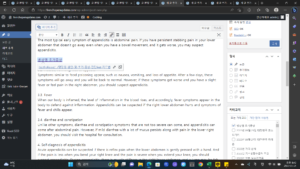One of the diseases that come unexpectedly acutely is appendicitis. Appendicitis, also called acute appendicitis, is one of the diseases that suddenly cause pain and require emergency surgery as needed. If you are familiar with the early symptoms of appendicitis and have abdominal pain that corresponds to the symptoms, you should go to the hospital and get treatment. Let’s learn about the early symptoms and causes of appendicitis.
index
1. What is appendicitis?
2. Appendicitis causes
3. Early symptoms of appendicitis
3.1. abdominal pain
3.2. Nausea, vomiting, loss of appetite
3.3. Fever
3.4. diarrhea and constipation
4. Self-diagnosis of appendicitis
5. How to treat appendicitis
1. What is appendicitis?
The correct diagnosis of this disease, commonly known as appendicitis, is acute appendicitis. In Korea, more than 100,000 people undergo surgery for acute appendicitis every year. It is easy to see people who are undergoing surgery for appendicitis, and it is such a common operation.
Although the surgical procedure is simple compared to other diseases, care must be taken because it can lead to complications if it is mistaken for simple enteritis and the operation is not performed quickly.
The food we eat passes through the esophagus, stomach, small intestine, large intestine, and anus. There is an appendix about 10 cm long at the beginning of the large intestine and at the end of the small intestine. When this appendix becomes inflamed, it is called acute appendicitis. The appendix is located on the right lower abdomen in the shape of an elongated tail. This is why there is pain in the right lower abdomen when acute appendicitis appears.
2. Appendicitis causes
It can be caused by an infection with something such as bacteria, viruses, or parasites, or when stool hardens. When the lymphatic cells of the appendix proliferate, the opening of the appendix is blocked. At this time, bacteria multiply in the appendix, causing inflammation. When it increases within the cecum, it causes the cecum to bulge excessively. So the appendix can burst. If there is an appendix stone, it can cause acute appendicitis.
3. Early symptoms of appendicitis
early symptoms of appendicitis
early symptoms of appendicitis
early symptoms of appendicitis
3.1. abdominal pain
The most typical early symptom of appendicitis is abdominal pain. If you have persistent stabbing pain in your lower abdomen that doesn’t go away even when you have a bowel movement, and it gets worse, you may suspect appendicitis.
3.2. Nausea, vomiting, loss of appetite
Symptoms similar to food poisoning appear, such as nausea, vomiting, and loss of appetite. After a few days, these symptoms will go away and you will be back to normal. However, if these symptoms get worse and you have a slight fever or feel pain in the right abdomen, you should suspect appendicitis.
3.3. Fever
When our body is inflamed, the level of inflammation in the blood rises, and accordingly, fever symptoms appear in the body to defend against inflammation. Appendicitis can be suspected if the right lower abdomen hurts and symptoms of fever and chills appear.
3.4. diarrhea and constipation
Unlike other symptoms, diarrhea and constipation symptoms that are not too severe can come, and appendicitis can come after abdominal pain. However, if mild diarrhea with a lot of mucus persists along with pain in the lower right abdomen, you should visit the hospital for consultation.
4. Self-diagnosis of appendicitis
Acute appendicitis can be suspected if there is reflex pain when the lower abdomen is gently pressed with a hand. And if the pain is less when you bend your right knee and the pain is severe when you extend your knee, you should suspect appendicitis. During appendicitis, there is muscle stiffness in the right lower abdomen, and a lump may be felt due to a boil.
In the hospital, appendicitis is diagnosed based on the patient’s symptoms, tests, and increased white blood cells. Acute inflammatory diseases increase the number of white blood cells during blood tests. Ultrasound is useful when the appendix has ruptured or enlarged and becomes inflamed. Depending on the patient’s condition, urine tests, blood tests, and CT scans are performed.
Unlike other diseases, there are no specific preventive measures for appendicitis. That’s why if you have any suspicious symptoms of appendicitis, you should see a doctor quickly. Common abdominal pain gets better with time, but appendicitis is characterized by worsening pain over time. If the pain is different from the abdominal pain you have felt so far, or if the pain between the navel and the pelvis increases gradually, you should get an appendicitis test.
early symptoms of appendicitis
5. How to treat appendicitis
Appendicitis is treated with antibiotics in the early stages or with mild symptoms, but in most cases of appendicitis, the appendix is removed surgically. Antibiotics are given before and after surgery to reduce bacterial infection. If inflammation has formed an abscess, surgery is not performed immediately, but a drainage tube is inserted to drain the abscess and antibiotics are administered to subside the inflammation. An appendectomy is then performed 6 to 12 days later. Postoperative complications occur in 5% to 10% of nonperforated appendicitis and 15% to 65% of those with perforated appendicitis. Perforation occurs in 20% of patients within 24 hours of the onset of inflammation and 70% within 48 hours, requiring emergency surgery.
Perforation is more likely to occur in the elderly or in children with an immature serous membrane. Infection is the most common complication. If the infection is severe or an abscess has formed, it may appear in the pelvis, under the diaphragm, or in the abdominal cavity. A fistula may develop between the intestine and the skin if the intestinal wall is weakened or if the surgical section leaks. Intestinal obstruction may occur after surgery. The timing at which these bowel obstructions may appear varies from immediately after surgery to many years after surgery.
